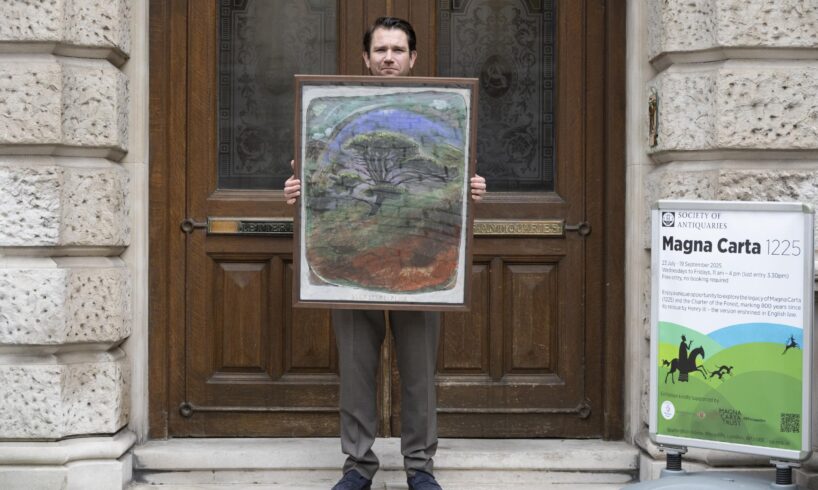
Proceeds from the sale of the painting, and limited edition prints of it, will go towards conservation charity Trees for Life’s work to restore the globally unique pinewoods and save them from being lost forever.
The exhibition marks the 800th anniversary of the issuing of the definitive versions of the Magna Carta and the Charter of the Forest in 1225. The Charter drew together the forest-related rules established by the Magna Carta and is widely regarded as the UK’s first environmental legislation.
The Caledonian pinewoods – home of iconic Scottish wildlife such as red squirrel, golden eagle, capercaillie and wildcat -– have been reduced to less than 2% of their original area across just 84 officially recognised remnants, scattered across the Highlands and often in poor condition.
READ MORE:
According to Trees for Life, Dan Llywelyn Hall’s painting of the 567-year-old Glen Loyne Pine “brings this situation into stark reality”.
Steve Micklewright, chief executive of Trees for Life, said: “Dan’s atmospheric painting of the Glen Loyne Pine – standing alone in the dramatic Highland landscape – shows the desperate plight of many of our native pinewoods. His brush strokes say more about the situation than words ever can.
“Scotland’s native pinewoods should be playing a key role in the fightback against the nature and climate emergencies, but most are on their last legs. We need urgent landscape-scale restoration and rewilding – backed by the Scottish Government – to save, expand and connect up these precious woodlands before it’s too late.”
Artist Dan Llywelyn Hall with Glen Lloyne Pine painting at the Society of Antiquaries, London (Image: Malcolm Park)The woodlands once covered 1.5 million hectares of the Highlands, but over time were felled for timber or to create land for grazing. Overgrazing by deer, which browse on young pine saplings, is now the main reason for their continued decline.
A detailed analysis by Trees for Life into the condition of most of the known pinewood remnants recently concluded that high impacts from artificially large deer populations are the main barrier to the pinewoods’ recovery, and that many of the remnants will be lost without urgent measures to help them recover.
At a major conference last autumn, 25 organisations – including charities Trees for Life and Woodland Trust Scotland, and [[pub]]lic agencies Forestry and Land Scotland and NatureScot – agreed to form the Caledonian Pinewood Partnership to boost restoration efforts.
Cardiff-born Dan Llywelyn Hall is a painter known for vivid paintings, including landscape and portraiture. His portrait commissions include Her Majesty The Queen in 2013, when Dan became the youngest artist to portray the monarch.
He said: “The Glen Loyne pine has lived through major historical events, including the execution of Mary Queen of Scots, Jacobite Rebellions, creation of the United Kingdom, and Second World War. We must ensure that a new generation of Scots pine can grow that can bear witness to the events of the next 500 years.
“I hope the new Caledonian Pinewood Partnership will be inspired by the Charter of the Forest and develop a new charter for Scotland’s pinewoods, one where harmony between nature and human needs is paramount.”
The ‘Magna Carta 1225: 800th Anniversary Exhibition’ at the Society of Antiquaries runs until 19 September, and also features three other newly commissioned paintings by the artist. All depict ancient forests or specific trees alive when the Charter of the Forest was drawn up by representatives of King Henry III in 1217.
Following the exhibition, the different paintings will then be sold to raise funds for Trees for Life, the Society of Antiquaries Library and Collection, and other beneficiaries.
Many of the surviving Caledonian pinewoods are in ancient forests – land once reserved for the monarch and aristocracy for hunting.
The Glen Loyne Pine has been dated to at least 1458 by St Andrews Tree-Ring Laboratory, and is believed to be even older. It is located in a remote ancient woodland of some 57 pines, all several centuries old, scattered through Glen Lloyne in the northwest Highlands.





